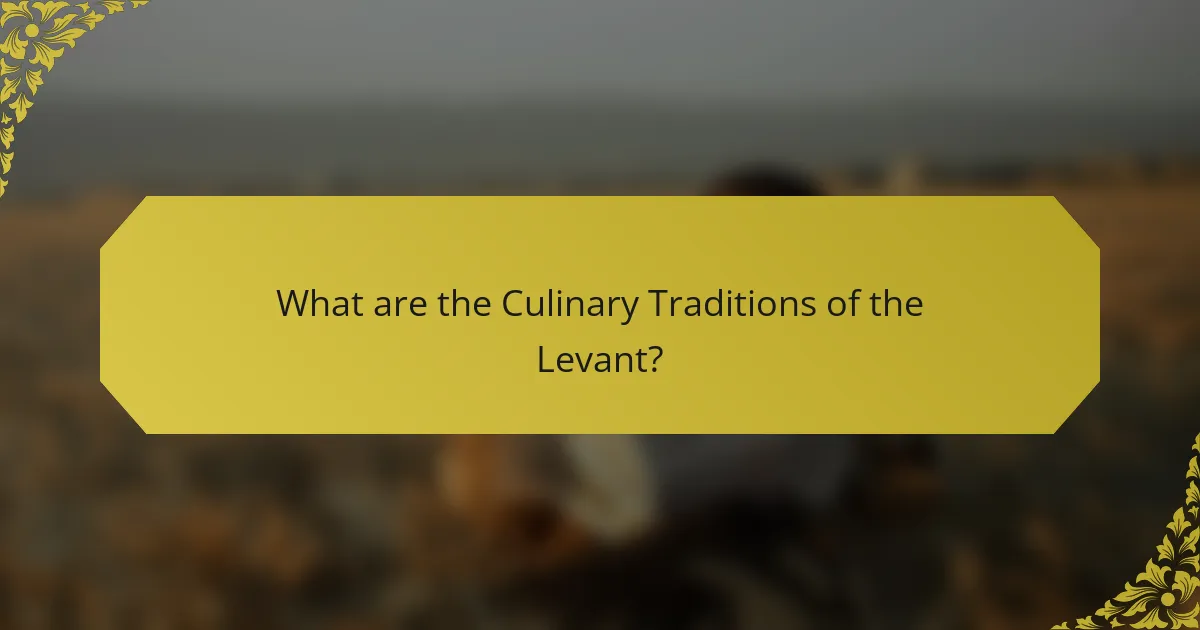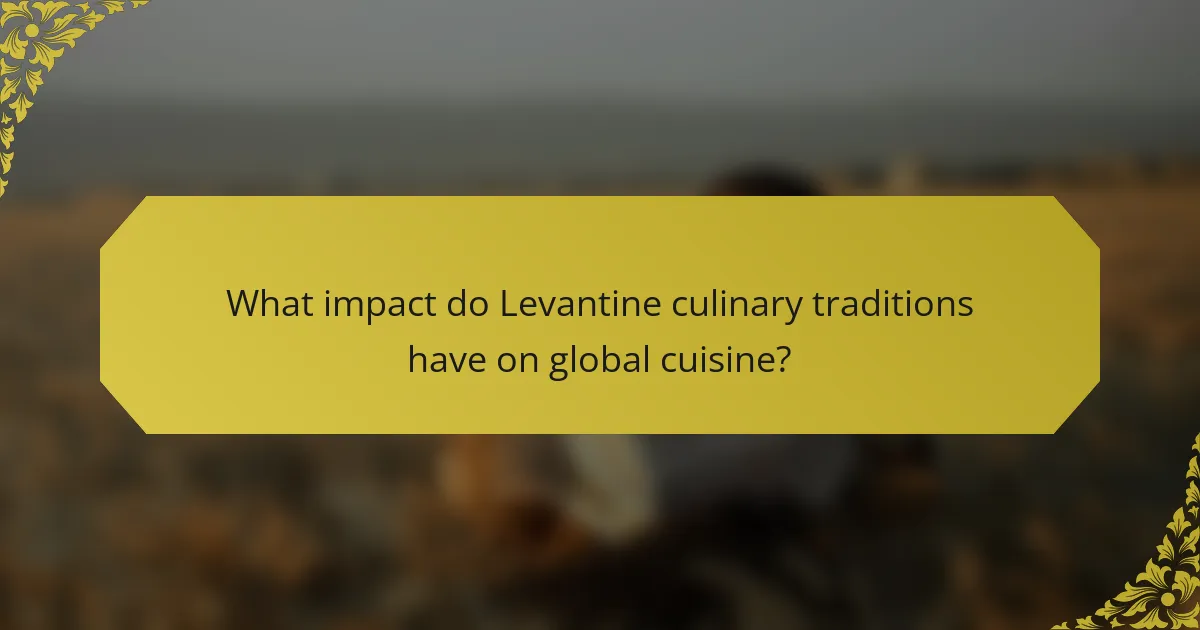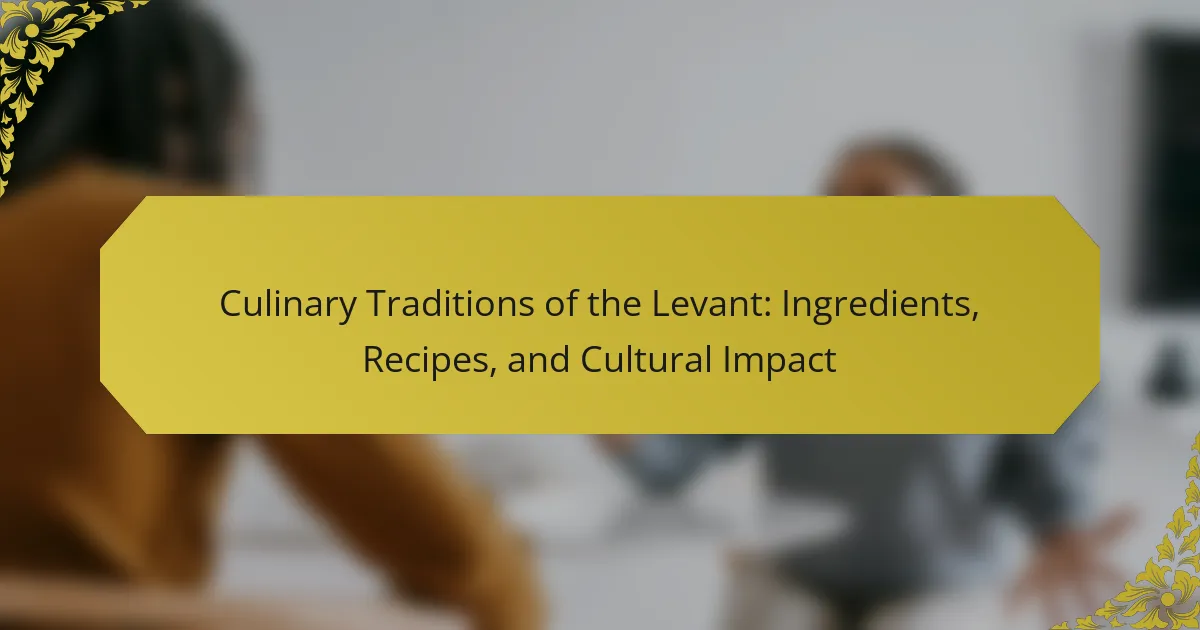
What are the Culinary Traditions of the Levant?
The culinary traditions of the Levant encompass a rich tapestry of flavors and techniques. This region includes countries like Lebanon, Syria, Jordan, and Palestine. Key ingredients feature olive oil, fresh vegetables, grains, and spices. Dishes often highlight mezze, which are small plates served as appetizers. Popular mezze include hummus, tabbouleh, and baba ghanoush. Grilled meats, such as kebabs and shawarma, are also central to Levantine cuisine. Bread, particularly pita, serves as a staple accompaniment. The culinary practices reflect a blend of cultural influences from various historical periods. These traditions emphasize communal dining and hospitality, showcasing the region’s social values.
How do the culinary traditions reflect the cultural diversity of the Levant?
Culinary traditions in the Levant reflect the region’s cultural diversity through a rich tapestry of flavors and techniques. The Levant encompasses countries like Lebanon, Syria, Jordan, and Palestine, each contributing unique dishes. Ingredients such as olive oil, spices, and grains are common across these cultures. Traditional dishes like hummus and tabbouleh showcase the blending of various cultural influences. For example, the use of herbs in tabbouleh reflects the agricultural practices of the region. The historical trade routes have also introduced diverse ingredients, enriching local cuisines. Festivals and communal meals highlight the importance of food in cultural identity. Overall, culinary traditions serve as a narrative of the Levant’s historical interactions and cultural exchanges.
What historical influences shaped the culinary practices in the Levant?
Culinary practices in the Levant have been shaped by various historical influences. The region has experienced a blend of cultures due to trade, conquests, and migrations. Ancient civilizations like the Phoenicians introduced spices and cooking techniques. The Roman Empire contributed methods of preservation and new ingredients. Arab conquests brought diverse flavors and cooking styles. Ottoman rule further integrated various culinary traditions from across its empire. The Levant’s geographic location facilitated the exchange of ingredients with neighboring regions. Each of these influences has left a lasting impact on the food culture, creating a rich tapestry of flavors and dishes.
How do regional variations impact Levantine cuisine?
Regional variations significantly impact Levantine cuisine by influencing ingredient availability and cooking techniques. Each region, such as Lebanon, Syria, Jordan, and Palestine, has distinct agricultural products. For example, coastal areas have access to fresh seafood, while mountainous regions utilize herbs and wild greens. Cooking methods also vary; grilling is prevalent in some areas, while stewing is common in others. Traditional dishes reflect these differences, with variations in spices and preparation methods. Additionally, cultural exchanges and historical influences shape local flavors, resulting in unique interpretations of common dishes. This diversity enriches Levantine cuisine, making it a vibrant tapestry of flavors and traditions.
What are the key ingredients used in Levantine cooking?
Key ingredients used in Levantine cooking include olive oil, garlic, lemon, and various spices. Olive oil is a staple for cooking and dressing dishes. Garlic adds depth and flavor to many recipes. Lemon provides acidity and brightness to the cuisine. Common spices include cumin, coriander, and sumac, which enhance the overall taste. Fresh herbs like parsley and mint are frequently used for garnish and flavor. Legumes, particularly chickpeas and lentils, are essential sources of protein. Grains such as bulgur and rice are also fundamental in many dishes. Vegetables like eggplant, tomatoes, and bell peppers are widely incorporated into Levantine meals.
What role do spices play in Levantine dishes?
Spices are essential in Levantine dishes, enhancing flavor and aroma. They contribute to the region’s rich culinary identity. Common spices include cumin, coriander, and sumac. These spices provide a balance of heat, sweetness, and acidity. Their use dates back centuries, reflecting historical trade routes. Spices also have cultural significance, symbolizing hospitality and tradition. The combination of spices creates unique and memorable dishes. This culinary practice fosters community and shared experiences.
How are fresh herbs utilized in traditional recipes?
Fresh herbs are essential in traditional Levantine recipes for flavor and aroma. They enhance dishes like tabbouleh, where parsley is a key ingredient. Fresh mint is often used in salads and yogurt dishes, adding freshness. Cilantro features prominently in stews and sauces, contributing depth. Herbs are typically chopped and mixed with other ingredients for balanced taste. Cooking methods often involve sautéing herbs to release their essential oils. The use of fresh herbs reflects the region’s agricultural abundance and culinary heritage. Their incorporation is rooted in cultural practices, emphasizing health and flavor in meals.
What are some signature recipes from the Levant?
Signature recipes from the Levant include dishes like hummus, tabbouleh, and kibbeh. Hummus is a spread made from blended chickpeas, tahini, lemon juice, and garlic. It is a staple in many Levantine meals. Tabbouleh is a fresh salad primarily made from parsley, tomatoes, bulgur, and mint. It is known for its vibrant flavors and is often served as a mezze. Kibbeh consists of minced meat, usually lamb, mixed with bulgur and spices, shaped into balls or patties, and can be served raw or cooked. These recipes reflect the rich culinary heritage of the Levant, showcasing the region’s emphasis on fresh ingredients and bold flavors.
How is hummus traditionally prepared and served?
Hummus is traditionally prepared by blending cooked chickpeas, tahini, olive oil, lemon juice, garlic, and salt. The chickpeas are often soaked overnight and then boiled until tender. After boiling, they are drained and combined with the other ingredients in a food processor. The mixture is blended until smooth, creating a creamy texture. It is typically served in a shallow bowl, drizzled with olive oil, and garnished with paprika or parsley. Hummus is commonly enjoyed with pita bread or fresh vegetables. This preparation method reflects the dish’s roots in Levantine cuisine, where it is a staple.
What variations exist for tabbouleh across the Levant?
Tabbouleh variations across the Levant include differences in ingredients and preparation methods. In Lebanon, tabbouleh is primarily made with parsley, bulgur, tomatoes, and mint. Syrian tabbouleh often incorporates more tomatoes and less bulgur, resulting in a wetter consistency. Palestinian tabbouleh may include additional ingredients like pomegranate seeds or nuts for added texture. In Jordan, tabbouleh is sometimes served with a side of yogurt. Each variation reflects local tastes and available ingredients, showcasing the dish’s adaptability. These regional differences highlight the cultural significance of tabbouleh in Levantine cuisine.
How do culinary traditions influence social practices in the Levant?
Culinary traditions significantly influence social practices in the Levant. Food serves as a central element in social gatherings and celebrations. Traditional dishes are often prepared during religious and cultural festivals. Sharing meals fosters community bonding and strengthens familial ties. Culinary practices also reflect regional identities and cultural heritage. For instance, specific ingredients are tied to local customs and historical narratives. The Levant’s diverse cuisines promote hospitality and generosity. Meals are often communal, emphasizing togetherness and social interaction. Overall, culinary traditions play a vital role in shaping social dynamics in the Levant.
What are the connections between Levantine cuisine and hospitality customs?
Levantine cuisine is deeply intertwined with hospitality customs. In Levantine culture, sharing food is a fundamental expression of welcome and generosity. Traditional meals often involve communal dishes, encouraging social interaction among guests. The preparation of elaborate meals signifies respect and honor towards visitors. Specific dishes, such as mezze, are served to create a warm and inviting atmosphere. Additionally, offering food to guests is seen as a moral duty in many Levantine communities. This practice fosters strong social bonds and reinforces community ties. Overall, the connections between Levantine cuisine and hospitality customs reflect cultural values of sharing, respect, and togetherness.

What impact do Levantine culinary traditions have on global cuisine?
Levantine culinary traditions significantly influence global cuisine. They introduce unique flavors and techniques that enhance diverse culinary practices. Dishes such as hummus and tabbouleh have gained worldwide popularity. The use of spices like sumac and za’atar adds depth to various cuisines. Levantine cooking emphasizes fresh ingredients and healthful preparation methods. This focus aligns with modern dietary trends favoring plant-based and wholesome foods. Additionally, the communal dining culture of the Levant encourages shared meals, impacting social dining experiences globally. Overall, Levantine culinary traditions enrich global cuisine through their distinctive ingredients and cultural practices.
How has Levantine cuisine influenced Mediterranean diets?
Levantine cuisine has significantly influenced Mediterranean diets through its diverse ingredients and cooking techniques. Key elements include the use of fresh vegetables, herbs, and spices. Dishes like hummus and tabbouleh have become staples in Mediterranean diets. The emphasis on olive oil as a primary fat source has also been widely adopted. Additionally, the Levant’s culinary practices promote the consumption of legumes and grains, enhancing nutritional value. Historical trade routes facilitated the exchange of culinary ideas across the region. This cultural exchange has led to a blending of flavors and cooking methods. Overall, Levantine cuisine has enriched the Mediterranean diet, making it more varied and health-conscious.
What are some popular dishes that originated from the Levant?
Popular dishes that originated from the Levant include hummus, tabbouleh, and falafel. Hummus is a spread made from blended chickpeas, tahini, lemon juice, and garlic. Tabbouleh is a salad consisting of parsley, tomatoes, bulgur, and mint, dressed with olive oil and lemon. Falafel consists of deep-fried balls made from ground chickpeas or fava beans. Shawarma, a meat dish, is also widely enjoyed, featuring marinated meat cooked on a vertical rotisserie. These dishes reflect the rich culinary heritage of the Levant region. They are staples in Levantine cuisine and are enjoyed globally.
How have Levantine flavors been integrated into modern culinary trends?
Levantine flavors have been integrated into modern culinary trends through the incorporation of traditional spices and cooking techniques. Ingredients such as za’atar, sumac, and tahini are increasingly featured in contemporary dishes. Chefs are blending these flavors with global cuisines, creating fusion dishes that highlight Levantine influences. For instance, Middle Eastern-inspired hummus has gained popularity as a versatile dip in various culinary settings. Additionally, Levantine dishes like shawarma and kebabs are now commonplace in urban restaurants worldwide. This integration reflects a growing appreciation for the rich culinary heritage of the Levant. Food festivals and cooking classes also promote Levantine cuisine, increasing its visibility in modern gastronomy.
What role does food play in Levantine festivals and celebrations?
Food plays a central role in Levantine festivals and celebrations. It serves as a means of cultural expression and communal bonding. Traditional dishes are often prepared and shared among families and communities. These meals reflect the region’s diverse culinary heritage. Ingredients commonly used include grains, vegetables, and meats, which symbolize prosperity and abundance. Specific festivals feature unique foods that hold symbolic significance. For example, during Eid al-Adha, lamb is often served to commemorate sacrifice. Food also acts as a medium for storytelling and preserving traditions. Sharing meals reinforces social ties and fosters a sense of belonging within the community.
How are traditional dishes featured during religious holidays?
Traditional dishes are prominently featured during religious holidays as a means of cultural expression and communal celebration. These dishes often hold significant symbolic meanings tied to the religious observances. For instance, during Ramadan, special meals like iftar include traditional foods that reflect local customs and ingredients. Similarly, during Easter, dishes such as maamoul are prepared and shared among families, symbolizing unity and festivity. The preparation and sharing of these dishes reinforce familial bonds and cultural identity. Historical practices show that these culinary traditions have been passed down through generations, maintaining their relevance in contemporary celebrations. Additionally, the use of specific ingredients often aligns with the themes of the holiday, enhancing the overall significance of the meal.
What significance do communal meals hold in Levantine culture?
Communal meals in Levantine culture signify deep social bonds and shared identity. These meals serve as a means of fostering community and family ties. They often involve the sharing of traditional dishes, reflecting cultural heritage. Engaging in communal dining allows for storytelling and the passing down of traditions. The practice is rooted in hospitality, which is a valued trait in Levantine societies. Research indicates that these gatherings promote social cohesion and emotional well-being. They also play a role in religious and festive occasions, reinforcing cultural practices. Overall, communal meals are essential for maintaining cultural continuity in the Levant.

How can one explore Levantine culinary traditions at home?
To explore Levantine culinary traditions at home, one can start by researching traditional recipes. Classic dishes include tabbouleh, hummus, and falafel. These recipes often highlight fresh ingredients like parsley, chickpeas, and spices.
Next, sourcing authentic ingredients is essential. Look for Middle Eastern markets or online stores that offer specific spices such as sumac and za’atar. Cooking methods also play a significant role. Techniques like grilling and slow cooking are common in Levantine cuisine.
Engaging with the culture enhances the experience. Watching cooking shows or YouTube channels focused on Levantine cooking can provide visual guidance. Joining online communities or forums dedicated to Levantine cuisine can also offer support and inspiration.
Finally, hosting a Levantine-themed dinner can be a fun way to share these traditions. Preparing a variety of dishes allows for a broader exploration of flavors and cooking styles. This approach not only teaches cooking skills but also fosters appreciation for Levantine culture.
What are some tips for cooking authentic Levantine dishes?
Use fresh, high-quality ingredients for authentic Levantine dishes. Fresh herbs like parsley, mint, and cilantro are essential. Incorporate spices such as cumin, coriander, and sumac for depth of flavor. Utilize traditional cooking methods like grilling, roasting, and slow-cooking to enhance taste. Master the art of making staples like pita bread and hummus from scratch. Pay attention to regional variations in recipes, as they can differ significantly. Use olive oil generously, as it is a key component in many Levantine dishes. Lastly, serve meals with a variety of mezze to create a communal dining experience.
How can beginners source ingredients for Levantine recipes?
Beginners can source ingredients for Levantine recipes by visiting local Middle Eastern grocery stores. These stores often carry essential spices, herbs, and specialty items. Common ingredients include sumac, za’atar, and tahini. Farmers’ markets can also provide fresh produce typical in Levantine cuisine. Items like eggplants, tomatoes, and cucumbers are frequently used. Online retailers offer a wide variety of Levantine ingredients for those without local access. Websites specializing in international foods can be particularly useful. Community groups or cooking classes may also provide guidance on sourcing ingredients. These methods ensure access to authentic flavors and components essential for Levantine dishes.
What are common mistakes to avoid when preparing Levantine meals?
Common mistakes to avoid when preparing Levantine meals include using low-quality ingredients. Freshness is crucial for authentic flavors. Many overlook the importance of proper seasoning. Balancing spices enhances the dish’s complexity. Not allowing enough marinating time can lead to bland results. Marinating meats for several hours improves taste and tenderness. Additionally, improper cooking techniques can ruin textures. For example, overcooking vegetables can make them mushy. Ignoring traditional methods can also detract from authenticity. Understanding cultural cooking practices ensures a genuine Levantine experience.
The main entity of the article is the culinary traditions of the Levant, which include the diverse cuisines of Lebanon, Syria, Jordan, and Palestine. The article provides an overview of key ingredients such as olive oil, fresh vegetables, and spices, along with signature dishes like hummus, tabbouleh, and kebabs. It explores the historical influences that have shaped these culinary practices, the role of communal meals and hospitality customs, and the impact of Levantine cuisine on global food trends. Additionally, the article offers insights into regional variations, cooking techniques, and tips for preparing authentic Levantine dishes at home.


